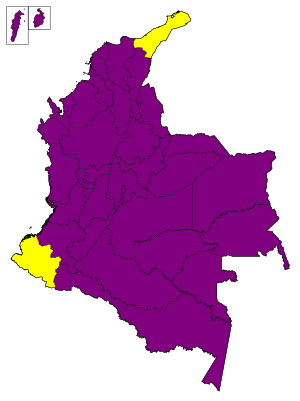Colombian presidential election, 2006
|
|
|||||||||||||||||||||||
|---|---|---|---|---|---|---|---|---|---|---|---|---|---|---|---|---|---|---|---|---|---|---|---|
|
|||||||||||||||||||||||
| Turnout | 45.1% |
||||||||||||||||||||||
|
|||||||||||||||||||||||

Results by Department
|
|||||||||||||||||||||||
|
|||||||||||||||||||||||
Álvaro Uribe
Colombia First
Álvaro Uribe
Colombia First
The 2006 Colombian presidential election was held on 28 May 2006. Álvaro Uribe was re-elected as President of the Republic and will serve another four-year term, starting on 7 August 2006. Uribe obtained 62.20% of the votes, thus surpassing the 50% needed to avoid a runoff against the second place candidate.
Following a constitutional amendment enacted by the government, this was the first occasion in over 100 years that a Colombian president was eligible for immediate re-election.
See also Elections in Colombia
Traditionally, Colombian politics have been dominated by two major political parties: the Colombian Conservative Party and the Colombian Liberal Party. However, 2002 presidential candidate Álvaro Uribe broke with precedent by splintering from the Liberal Party and campaigning as an independent under the unrecognized party, Colombia First. Due in part to declining public support for dialogue with FARC following president Andrés Pastrana Arango's failed ceasefire agreement, Uribe gained an edge over his liberal opponent, Horacio Serpa.
Colombia is a presidential republic wherein a president is elected by absolute majority vote in one or two rounds. Although the government of Colombia is separated into legislative, judicial, and executive branches, the President of Colombia serves as both the nation's head of state and head of government (as per the American model). Before 2005 and after a congressional vote in 2015, the president is prohibited from seeking reelection; however, a constitutional reform backed by incumbent president Álvaro Uribe suspended the term limit, allowing him to campaign for reelection in 2006.
...
Wikipedia


